This paper will be written in such a way as to simultaneously constitute a polemic with Mr.: Prof. Bruno Burger (department head of "New Devices and Technologies” at Fraunhofer) and Romain Zissler, Senior Researcher, Renewable Energy Institute.
First, we will write it in the form used by renewable energy lobbyists..
* According to ENTSOE, the installed capacity of wind turbines and photovoltaics has already reached 159 GW (data as of the beginning of 2025).
* The production of wind turbines and photovoltaics (including self-consumption) has already reached 209 TWh.
* In relation to the total production of 469 TWh, the production of wind turbines and photovoltaics has already reached 44.4%.
Theoretically, as many as three successes have been described. It is very good that we provide raw data, but sometimes providing such data without scientific study may be insufficient and mislead the reader, let's see.
The year 2024 had 8784 h. Therefore, the average production of wind turbines and photovoltaics was at the level of 209*1000/8784 = 23.7 GW. Total production was on average 469*1000/8784=53.4 GW.
Therefore, the construction of as much as 159 GW of installed capacity resulted in only 23.7 GW of production (14.9%). At the same time, we would like to note that 159 GW of installed capacity in relation to the production of 53.4 GW calculated with auto-consumption is almost 300%. We can therefore say that almost 300% of the installation capacity was used in only 14.9%. This is not a success.
Therefore, a characteristic feature of the statements of green lobbyists is to provide the reader with information without a point of reference. The author did not perform any manipulation and used the same set of data. The author only compared the installed capacity of wind turbines and PV with their production and with total production. The author's own invention consisted only in reducing the given values to the same units of power.
Fig. 1. Total production (average power) of German wind turbines, photovoltaics and nuclear for the years 2015-2024.
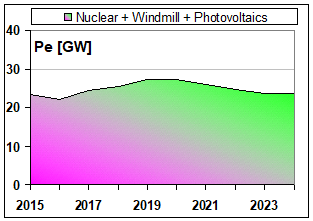
The total production of nuclear, wind and PV at the beginning and at the end of the period most interesting to us is practically the same, see Fig. 1. The Germans do not hide it, the Germans are proud of it. But then where is the benefit to the climate? A completely thoughtless exchange of nuclear power for renewable energy was made. Production that does not emit CO2 was exchanged for production that does not emit CO2. Word game for billions? Maybe it would have been better to buy a crossword? Whatever we write below, whatever additional circumstances we find, we must admit that the flagship operation of the German Greens did not make sense and burning shame will accompany them until the end.
"The Planet is Burning", 2024 was the warmest year in history, while Germany is implementing phobias based on fear of the tsunami in Bavaria? The author has an education in the exact field and probably knows the operation of the power plant and the threats it generates better than the greens. However, he assures that the tsunami did not threaten German power plants. With such power of science and technology, you were unable to explain to voters that it is possible to design safer nuclear power plants, and the risk of their operation, considering the climate threat, is justified?
Yes, electricity production from fossil fuels has declined, see Figure 2.
Fig. 2. Total production including self-consumption and production from fossil fuels for Germany in 2024.
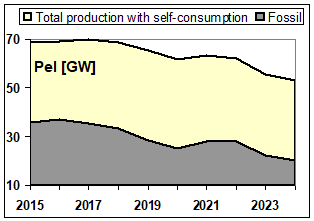
Production fell because fossil fuel plants have the capacity to regulate. If total demand fell, it was these plants that did it. The curves in Fig.2 are perfectly correlated.
Total demand could have fallen for the following reasons:
- self-consumption (but this has been taken into account),
- economic recession,
- transfer of production to other countries.
The last two reasons do not bring glory to the German Greens.
Comparing the years 1990-2024 we can see some slight progress, see fig. 3.
Fig. 3. Total production (average power) of German wind, photovoltaic and nuclear power for the years 1990-2024.

Fossil fuel production fell by 17.7 GW. Nuclear + wind + photovoltaic production increased by only 7.2 GW, so the sources of "success" lie elsewhere. 4.5 GW was produced on biomass, but this is not a success for wind, and besides, burning biomass is a controversial process. The rest of the decline in fossil fuel production is due either to the recession or to the switch to imports: this is also not a success for wind and photovoltaics.
We also need to compare the size of the actions taken with the effects, see Figures 4 and 5.
Fig. 4. Comparison of installed capacity of wind turbines and photovoltaics with the change in production on fossil fuels.
Fig. 5. Comparison of installed capacity of wind turbines and photovoltaics and production on fossil fuels in relation to total production.
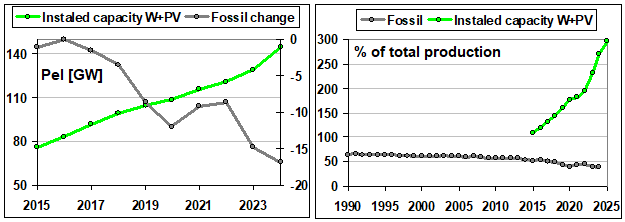
Comparing the years 2016 and 2024, we will say that a decrease in fossil fuel production by 17 GW was achieved at the cost of building 158 GW of wind turbines and photovoltaics. Comparing the years 1990-2024, we will say that the share of fossil fuels was reduced from 64.6% to 37.6% (∆=26.9%) by building wind turbines and photovoltaics with a capacity of 300%. Was it worth it?
There is no doubt that Germany has become an importer of electricity, see Figure 6.
Fig. 6. Electricity imports in Germany for the years 2015-2024.
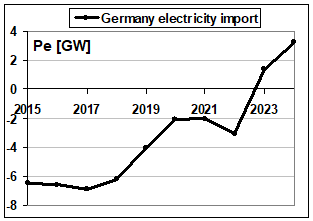
Green lobbyists give some fantastic explanations for this situation.
Yes, we import, but we import mainly green energy.
We import because the French have renovated their nuclear reactors.
Is this a French or German success? Why did the Germans consider nuclear reactors bad, when they are now good?
Yes, we import, but that's good, because we import cheaper energy than here.
Jesus Christ, in normal economics terms this means that our production has become uncompetitive…
Yes, we import, but this is our conscious purchasing decision.
Here, a longer explanation is needed. For the English name "potatoes" there are two parallel terms in Poland, one in the native language and the other borrowed from the German language "kartofle-Kartofelln". So the allusion will be understandable to both nations. Namely, the supply of Kartofelln is not the same as the supply of electricity. It cannot be said that producing, for example, 100 TWh on wind turbines and PV means exactly the same operating conditions of the system as producing 100 TWh in nuclear power plants.The electrical power balance must be met at instantaneous values. For a quarter of a century, the Greens have consistently ignored and trivialized the issue of the balance of power, or given evasive answers such as "appropriate storage systems will be invented in the future."
We will use an example for a selected day in mid-July 2024, see Figure 7 and Figure 8.
Fig. 7. Load and power curves of renewable and controllable sources on a sample day in mid-July 2024 in Germany.
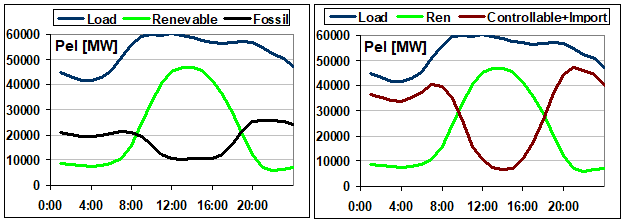
Fig. 8. Available regulatory bands for fossil fuels, expanded successively to include hydropower capacity and imports.
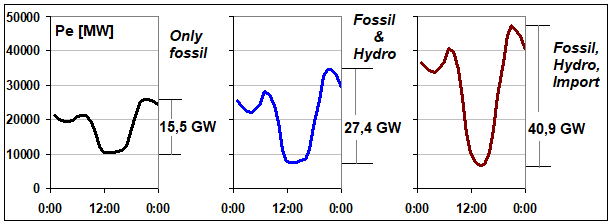
On the day under review, German controllable power plants offered a power range of 15.5 GW. This is a range of 40-100% power: good work. But unfortunately this is not enough to cover the changes forced by photovoltaics. The available control band was expanded to 27.4 GW using hydroelectric power plants, but this also turned out to be too little. Only by supplementing the control possibilities with forced import did it become possible to cover the changes in renewable generation amounting to 41 GW. The key to our explanations is the use of the word "forced". This is not a conscious purchase decision. Germany has lost its regulatory capacity.
Germany, nothing happened, we have spare power.
This is not entirely true: you have the power, but the excess of renewable does not allow you to use it properly. The changes in renewable power have exceeded the possibilities of control. Following the above, we will say that Germany also lost control.
What we have shown on the example of one day will also be shown on the scale of the entire year 2024, see fig. 9.
Fig. 9. Annual, ordered graph of the share of renewable energy sources in relation to demand and electricity exports in Germany for 2024.
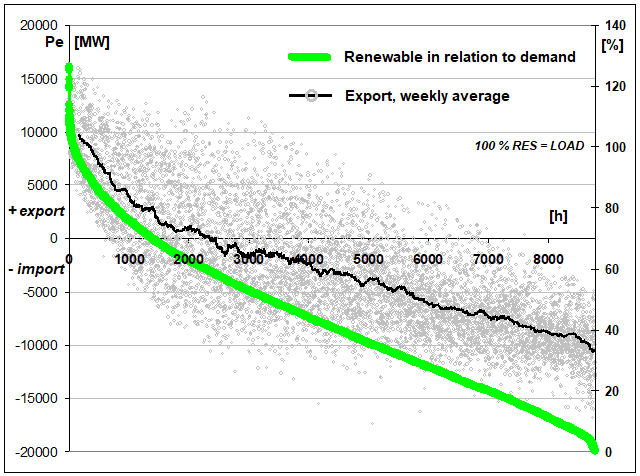
Above 58% share of RES in relation to demand, Germany most often has to export,
and import occurs most often when there are shortages of RES. Therefore, it is most often a situation forced by loss of control, and not a conscious commercial decision.
We should also not hope that prices will be favourable during forced imports, see Figure 10.
Fig. 10. Annual, ordered graph of exports and spot market prices in Germany for 2024.
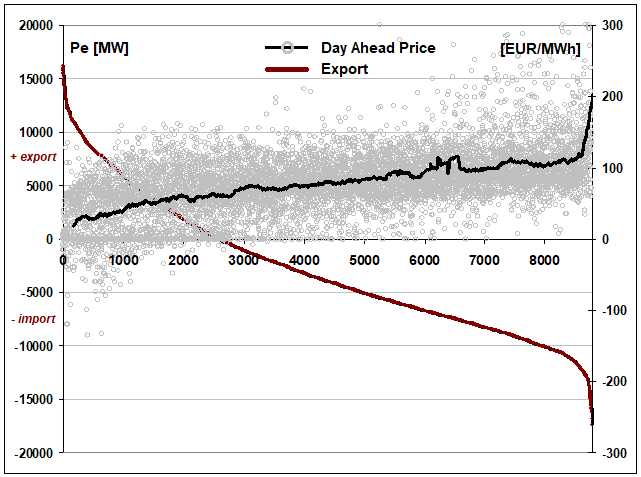
During export, there is the greatest chance that prices will be low. During import, prices will most often be high. Prices close to 1000 EUR/MWh are not shown in Figure 10, the unfavourable situation during the largest import is reflected in the trailing graph.
Energy prices in Germany have fallen and are lower than before the war in Ukraine.
Yes, they are lower, but they are still more than 2.5 times higher than before the introduction of the ETS CO2. According to the author, ETS it makes no sense, because renewable sources would have been built anyway using other support systems or by administrative decision. The fee was imposed on the necessary regulatory power plants, i.e. on the non-removable part of the system. The effect is a general increase in the prices of goods and services needed also to build sources that do not emit CO2.
Fig. 11. Spot prices of energy and CO2 in Poland for the years 2015-2025.
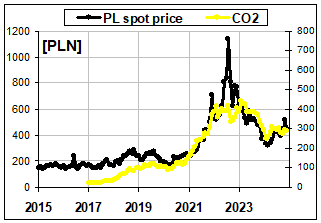
Prices are given in [PLN], but as you can see, the mileages shown are similar to those recorded in Germany.
Energy prices in Germany have fallen and are lower than before the war in Ukraine.
First, prices did not rise because of the war in Ukraine, but because of the neoliberal system of financing renewable sources based on an extremely unfair marginal cost mechanism. In 2022, gas production in Germany was only 11.1% of demand. Therefore, any speculation on gas could only affect 11% of production. This was not the case because the green liberals ensured maximum profits for renewable sources, always based on the most expensive possible energy price on the market.
The war in Ukraine was just a catalyst. The taxpayer has been robbed for many years. Financial irregularities are difficult to detect when a thief steals with a small spoon. The thief is caught only when he becomes greedy and changes the small spoon for a large one.
Energy prices in Germany have fallen and are lower than before the war in Ukraine.
Energy prices have fallen as European governments have moved renewables to long-term contracts, removing the potential for speculative gains on the stock market.
Romain Zissler, Senior Researcher, Renewable Energy Institute writes:
Germany is confronted with some transitory challenges which will be overcome thanks to renewable energy’s further expansion.
During the first few decades of his life, the author had heard enough about "temporary difficulties in building socialism". For more experienced people, such a statement is simply offensive.
As shown above, the momentary power of RES exceeded the regulatory capacity of German controllable sources. What happened is what rational people have been warning the greens about for years. The difficulties are not temporary, the difficulties are only just beginning. For his part, the author assures the greens that electricity storage cannot be invented. The problem is not the technology. The problem is the glaring disproportion between the power and the production of RES. Every attempt to solve this problem leads to the allocation of installations with a high fixed cost for peak operation. This contradicts the basic principles of economics. The conflict is embedded in the assumptions of renewable energy and is unresolvable.
So far, Germany has temporarily solved the problem by increasing energy imports from Scandinavia (imports from France were practically the norm). Is this a reference solution for the rest of Europe, Asia and the world in general? Will there be enough water in Norway for Poland if the German Greens make us shut down coal-fired power plants?
12. German photovoltaic production in 2024 in chronological and ordered charts.
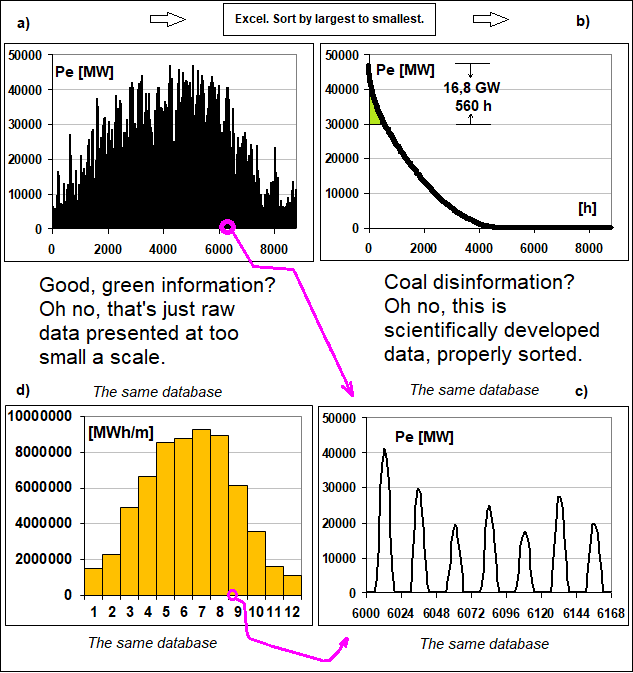
Please look at Figure 12, which shows German photovoltaic production in 2024 in chronological and ordered graphs. What do you think, in Figure 12.a) we have good green information and Figure 12.b) is „coal propaganda“? The truth is slightly different: in Figure 12.a) the raw data is presented on the wrong scale. It is too small and hides the "unusual" night phenomenon. It is only visible when the scale is extended to a sample week from 6000 h of year, see Figure 12.c). Both Figures 12.a) and 12.b) are based on the same database. However, in the case of Figure 12.b), a scientific study was made by pressing the "Sort" button in Excel. As can be easily seen, the same disinformation effect as in Fig. 12.a) is given by presentations using monthly bar charts. Monthly and annual performance given in [TWh] hide the weaknesses of RES, in particular they hide periods in which RES completely disappears.
With appropriately wide bars we forget about the existence of night, and yet night takes up half of the year!
Figure 12.b) shows in green an example range of 16.8 GW of power, which can be treated as a surplus for storage, conversion into hydrogen, etc. It is a triangle with a base of 560 h. It is impossible to maintain a complicated and expensive installation that would have such a large power and at the same time operate for such a short time. So, let us repeat, it is not "temporary difficulties" that hinder the development of RES. It is errors in the assumptions. A burning shame will accompany the German Greens until the end.
In the future, thanks to the increased share of RES, energy prices will fall.
Not true. The cost of a power plant system with renewable sources does not approach zero, nor does it approach the initial LCOE values of renewable sources. The cost of such a power plant system is also not a weighted average of the initial partial LCOEs. Wind turbines and photovoltaics are not stand-alone devices and can only operate as part of a larger set of energy installations. Expecting that the total cost of such a set of devices will approach the cost of renewable energy sources is wrong. In addition, we note that renewable energy sources deprived of speculative earnings on the stock exchanges issue higher costs in long-term contracts. In Poland, there has been a situation in which the energy cost of new wind turbines in offshore farms is higher than the cost of coal with the ETS.
A burning shame will accompany the German Greens until the end.
The work uses data from www.energy-charts.info and ENTSOE. These data do not always match. The data were selected in good faith and with care to ensure they were consistent.
21.01.2025 Grzegorz Kwiecień